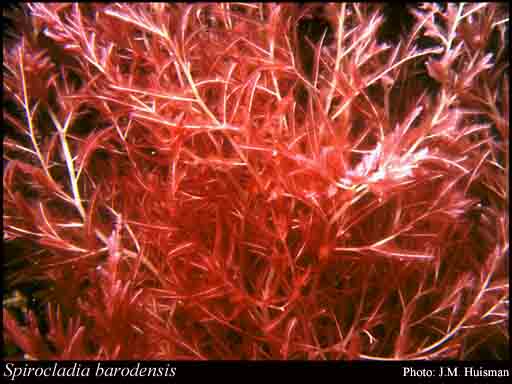- Reference
- Biol.Meddel.Kongel.Danske Vidensk.Selsk. 10(8):3-16, Figs 1-10 (1933)
- Conservation Code
- Not threatened
- Naturalised Status
- Native to Western Australia
- Name Status
- Current

Scientific Description
Habit and structure. Thallus pale red to brownish red, to 15 mm tall, erect, with percurrent primary axes bearing lateral polysiphonous branches every 1.5–2.5 mm. All axes with persistent pigmented trichoblasts arising 1 per segment in a spiral sequence, heavily corticated to near the apices, the cortication obscuring the segments. Primary axes to 1.2 mm diam. near the base, tapering gradually to 100 µm diam. near apices [segment L:B 0.35–0.5]. Trichoblasts to 2.4 mm long, up to 12 times subalternately branched, all cells cylindrical, elongate, 10–15 µm diam. [L:B to 10]. Apical cells with rounded or slightly tapering tips. Cortication initiating c. 400 µm below branch apex, arising as basipetal cells from corners of pericentral cells, eventually forming a thick cortical layer with slightly elongate, irregularly shaped surface cells. Adventitious trichoblasts commonly arising from surface cortical cells.
Reproduction. Tetrasporangia arising in stichidial upper regions of trichoblasts, up to 10 observed per stichidium but, additionally, with up to 10 empty segments proximally, 1 per segment in a spiral pattern, sequentially maturing, spherical, tetrahedrally divided, to 75 µm diam. Fertile region of stichidium with simple lateral branches up to 12 cells long, similar in form to trichoblast filaments.
Distribution. Widespread in warmer waters of the Indo-West Pacific; in Australia known from the Houtman Abrolhos Islands, north-western Australia, Port Essington, Northern Territory (and probably around northern Australia) to Coffs Harbour, New South Wales.
Habitat. epilithic, epizoic or epiphytic in the subtidal.
[After J.M. Huisman in Algae of Australia: Marine Benthic Algae of North-western Australia, 2. Red Algae: 572–574 (2018)]
Distribution
- IBRA Regions
- Dampierland.
- IBRA Subregions
- Pindanland.
- IMCRA Regions
- Canning.
- Local Government Areas (LGAs)
- Broome.